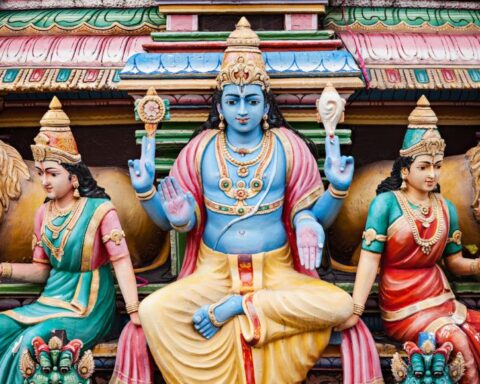The world’s primary religions fall into two categories: Abrahamic religions, such as Christianity, Judaism, and Islam; and Indian religions, which include Hinduism, Buddhism, Sikhism, and others. Of the world’s major religions, Christianity is the largest, with more than two billion followers.
How Many Religions Exist in the World
Determining the exact number of religions worldwide is a daunting, if not impossible task, and for many reasons.
Many religions can be difficult to tell apart for those not intimately familiar with their doctrine. Guidelines about what is a truly separate religion and what is simply a denomination (subdivision) are rare, if not nonexistent. Similarly the line between a spiritual, but non-religious experience and an actual religion can be different from person to person—for example, New Age practices, wicca, and even certain forms of yoga can be considered religion by some, but not to others.
Finally, there exists the uncomfortable question of how to count fringe sects and cults. Jim Jones’ famed (and ill-fated) Peoples Temple, for instance, taught an increasingly warped doctrine that no longer fit alongside traditional Christian denominations—but which also fell short of qualifying as a wholly separate religion.
One popular estimate claims there exist some 4000-4300 religions worldwide, but this number is highly disputed. It includes ancient belief systems such as Norse mythology, which are no longer practiced today. Moreover, it counts each of the various denominations in current religions separately—so Christianity, for example, does not count as one religion, but dozens: Protestant, Catholic, Lutheran, Methodist, Episcopalian, Assembly of God, and so on.
Christians
Christianity is based on the life and teachings of Jesus Christ and is approximately 2,000 years old. Its largest groups are the Roman Catholic Church, the Eastern Orthodox churches, and the Protestant churches, and its sacred text is the Bible. Over the centuries, Christianity grew in numbers as it spread around the world, often through missionaries and colonizers.
Christians remained the largest religious group in the world, making up nearly a third (31%) of Earth’s 7.3 billion people, according to a new Pew Research Center demographic analysis. But the report also shows that the number of Christians in what many consider the religion’s heartland, the continent of Europe, is in decline.
Christians had the most births and deaths of any religious group in recent years, according to our demographic models. Between 2010 and 2015, an estimated 223 million babies were born to Christian mothers and roughly 107 million Christians died – a natural increase of 116 million.
But among Christians in Europe the reverse is true: Deaths outnumbered births by nearly 6 million during this brief period. In Germany alone, there were an estimated 1.4 million more Christian deaths than births from 2010 to 2015. This natural decrease in Europe’s aging Christian population was unique compared with Christians in other parts of the world and other religious groups. In fact, Muslims and the unaffiliated in Europe both experienced natural increases in their populations, with our new report estimating that there were over 2 million and 1 million more births than deaths, respectively
Islam
The second most widely practiced religion is Islam, with an estimated 1.8 billion followers worldwide. It started in Mecca (a city in modern-day Saudi Arabia) in the 7th century CE and was spread by the Prophet Muhammad (570–632 CE), who followers of Islam believe to be God’s ultimate prophet. Islam states that the teachings of God, who is known as Allah, were written down in a holy book known as the Qurʾān, which is the faith’s spiritual text. Most Muslims belong to one of the two major branches of Islam: Sunnis include approximately 80 percent of Muslims, and the Shiʿah includes approximately 15 percent. The remaining numbers belong to smaller denominations.
Hinduism
Hinduism, with an estimated 1.1 billion followers, is the world’s third largest religion and also one of the oldest, with beliefs and practices that date back at least as far as the 1500s BCE. Hinduism is practiced primarily in India (where approximately 80 percent of the population identifies as Hindu), Nepal, and Indonesia. Little is known about the founding of Hinduism, but its teachings deeply influence almost all aspects of believers’ lives. In recent years certain aspects of Hinduism have become popular in the West, such as the practice of yoga, as well as the use of chakras (energy points found throughout the body) to identify and treat illness.
Buddhism
The fourth most widely practiced religion is Buddhism, with approximately 500 million followers worldwide and more than 250 million in China alone. Based on the teachings of Gautama Buddha, the religion was founded in India nearly 2,500 years ago. There are two main branches of Buddhism: Theravada Buddhism and Mahayana Buddhism. Tenets of Buddhism include a vow of nonviolence and an adherence to ethical behavior in all aspects of life.
One popular estimate claims there exist some 4000-4300 religions worldwide, but this number is highly disputed. It includes ancient belief systems such as Norse mythology, which are no longer practiced today. Moreover, it counts each of the various denominations in current religions separately—so Christianity, for example, does not count as one religion, but dozens: Protestant, Catholic, Lutheran, Methodist, Episcopalian, Assembly of God, and so on.
World Population by Religion
About 85% of the world identifies with a religion. The most popular religion is Christianity, followed by an estimated 2.38 billion people worldwide. Islam, which is practiced by more than 1.91 billion people, is second. However, population researchers predict that Islam will have nearly caught up to Christianity by 2050.
Other religions measured and projected include Hinduism, Buddhism, Judaism, adn two umbrella categories. The first is “folk religions”, which collects traditional African religions, Chinese folk religions, and both Native American and Australian aboriginal religions. The second is “other religions”, a catch-all that tracks smaller faiths such as Shintoism, Taoism, Sikhism, and Jainism.
Finally, a significant number of people—nearly 1.2 billion worldwide—remain nonreligious or have Atheist beliefs.
Below is each religion’s total estimated population for 2020:
- Christianity – 2.38 billion
- Islam – 1.91 billion
- Hinduism – 1.16 billion
- Buddhism – 507 million
- Folk Religions – 430 million
- Other Religions – 61 million
- Judaism – 14.6 million
- Unaffiliated – 1.19 billion
Christianity
The world’s largest religion is Christianity, which is practiced by almost 2.4 billion people. Christianity is divided into Eastern and Western theology, and within those divisions, six branches; Catholicism, Protestantism, Eastern Orthodoxy, Anglicanism, Oriental Orthodoxy, and Assyrians.
In Vatican City and the Pitcairn Islands, 100% of the population is Christian. In other nations, at least 93% of the population is Christian. Those nations are:
- American Samoa, Armenia
- Barbados
- East Timor, El Salvador
- Greece
- Kiribati
- Georgia
- Malta, Marshall Islands, Micronesia
- Papua New Guinea, Paraguay, Peru
- Romania
- Samoa, San Marino
- Tonga
- Venezuela
Islam
Islam is the world’s second-largest religion. People that practice Islam are known as Muslims. In the Maldives, Mauritania, and Saudi Arabia, 100% of inhabitants practice Islam. In these nations, at least 95% of inhabitants identify as either Sunni or Shi’a Muslim:
- Afghanistan, Algeria
- Comoros
- Iran, Iraq
- Kuwait
- Libya
- Morocco
- Pakistan
- Somalia, Sudan
- Tunisia, Turkey
- Yemen
There are 50 Muslim-majority countries worldwide, or countries where over 50% of the population is Muslim.
Hinduism
Hinduism is the third-largest religion globally. Hinduism is considered dharma, or way of life. It originated on the Indian subcontinent and is widely practiced throughout Southeast Asia. The four main denominations are Vaishnavism, Shaivism, Shaktism, and Smartism.
Unsurprisingly, India has the largest Hindu population but not the highest percentage of Hindus. There are 1.053 billion Hindus in India, about79.8% of the population. Nepal has the second-highest Hindu population at 23.5, 81.3% of the population.
Other countries with high Hindu populations are:
- Bangladesh
- Indonesia
- Pakistan
- Sri Lanka
- United States
- Malaysia
- United Kingdom
- Mauritius
Buddhism
Buddhism also originated in India and is based on the teachings of Buddha. Buddhists have unique traditions, values, and beliefs, such as reincarnation.
About 507 million people practice Buddhism worldwide. China has the largest Buddhist population of 244 million, followed by Thailand with 64.4 million and Japan with 45.8 million.
Cambodia has the highest percentage of Buddhists at 96.9%, followed by Thailand at 93.2% and Myanmar with 87.90%.
Other Religions
In some nations, traditional Chinese religions, including Confucianism and Taoism, are practiced. This is most frequently seen in these nations:
- China
- Hong Kong
- Macau
- Taiwan
Ethic and indigenous religions are practiced in many countries. In Guinea-Bissau and Haiti, an estimated 50% of the population follows one of these religions. Other nations where ethnic and indigenous religions are practiced include:
- Benin
- Burundi
- Cameroon
- Cote d’Ivoire
- Sudan
- Togo
Unaffiliated or Atheist
Finally, as mentioned, many people are not religious or Atheism. This is mostly seen in nations including Estonia, the Czech Republic, and Japan, where over three-quarters of the population is irreligious. Other nations with a high percentage of people without religion include:
- Denmark
- France
- Hong Kong
- Macau
- Norway
- Sweden
- Vietnam





